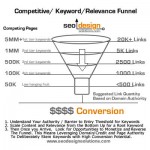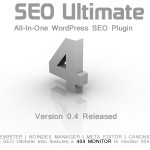Is there a magic SEO bullet for link building or building the proper quality, theme, volume or type of links? Not necessarily, but having a solid strategy and series of tactics at your disposal never hurts when applying the “think before you link” motto.

Link Building: SEO Link Types and Tactics
Whoever said links are not important for search engine optimization are merely trying to dissuade you from pushing their website aside in search engines if you acquire the proper type and mixture of link equity. Search engine rankings are collective by-product of content, site structure, popularity and links; but since this post is about links and their various metrics… let’s get right to the good stuff.
Search Engine Link Metrics:
- Link Reputation
- Authority /Trust
- Link Velocity
- IP Diversity
- Link Weight / Link Equity
- Topical Theme / Theme Relevance
- On Page Consistency
- Off Page Consistency or Diversity
There are fundamentally two types of links internal links (from page to page within your website) or external links (incoming inbound links from other websites) or the ones you build and the ones you earn. Each has its role and function within the grand scheme of things when sculpting link equity.
Of the various facets mentioned above, link reputation, link quality and trust outweigh link velocity or acquiring links from websites that are part of a questionable theme or link neighborhood.
Let’s Talk About Link Types
Link Reputation:
Link reputation is just that, the aggregate or culminating characteristic that an internal or external link has acquired.
Each link is viewed as a vote, get enough of them from the right sources and your website gains trust; that trust directly translates into link weight which you can invest into the page or pages of your choice via internal links.
Once a page reaches a certain degree of trust, all of the latent aspects of the (a) content (b) title meta data (c) H1 tag, bolded text, etc. and the various keyword combinations that exist on that page as well as the anchor text linking to that page are consolidated and that page can rank for (d) all of the above.
Authority / Trust:
To view the most trafficked and trusted websites online, just type in WWW into a Google search (with advanced filters set to 100 results). Every one of the sites listed there in descending order all represent the most authoritative sites online.
They are in such a lofty position since they are (a) linked to often (b) referenced often through citation or (c) visited frequently. This trifecta of link popularity and peer review augment the process of page and domain authority.
Getting a link from any website in the top 100 most trafficked or authoritative sites online (using the WWW keyword) could catapult your websites trust to a new level. The more authoritative pages your website has, the more trust, rankings and strength your overall domain can accrue.
How you spend that popularity (what we dub internally as ranking credit) and equity is up to you and ultimately determined by (1) the quality and topical theme of your content and (2) who you link to.
Once your website becomes a hub site (to other spokes in the wheel), each link is a valuable commodity which can be used to elevate other pages in your own website, pass traffic along to those who find that page (from search engines or through navigational means from other sites via links).
This is why it is particularly important to customize your website templates to prevent link loss through replicating too many shingles (text such as recurring navigation in the header, sidebar and footer).
By keeping the pages on topic and selectively using optimal anchor text, primary and secondary navigation and being selective with how you funnel the tiers within your website, you can sculpt link equity wisely within your website.
Trust is the last thing you get and it takes links from the right sources, quality content, popularity and time. Don’t squander it once you achieve it, but rather use it to consolidate your landing pages that have the highest degree of commercial intent for your monetization model.
You may have 2000 pages of content but use them to catapult 20 power-house landing pages into a top 3 position for an extremely competitive keyword. The ROI is passive income and massive quantities of traffic if you select the appropriate keywords, modifiers, action words and psychological triggers to entice prospects.
Link Velocity:
Link velocity is the rate in which you gain or lose links. If you are getting links from questionable sources in unnatural or high volume, this could invoke a potential “algorithmic quality control filter” which could imply shameless self promotion and / or automation and neutralize ranking momentum.
If the source of your links is a result a tactful social media barrage, a great article / resource or is a naturally occurring instance on your website, it has already “checked in” with search engines and they are aware of the spikes that translate into popularity – which is a vital metric for developing domain and page authority.
If you gained 200,000 links to your website in one month and then lost them all the next month that could potentially put your site on Google, Yahoo or Bing’s quality review teams list to investigate for foul play.
Velocity is one of the things you should never worry about if the link profile is natural or not under your control. Search engines will adjust based on spikes and do a good job at determining if the source is automated or natural.
IP Diversity:
Along the same lines as link diversity, websites that all belong to a range of IP addresses (such as hosted on the same server) do not pass the same extent of link flow once they reach a cap.
For example, if you received 1000 inbound links 10 websites (100 links each) via a sitewide link or blogroll, those links would be normalized and minimized compared to 1000 links from 100 websites or 1000 links from 1000 different websites.
The diversity of the footprint for inbound links correlates directly to the amount of citation your website receives. The smaller the footprint (IP range) the less link flow your pages receive (since this is typically the signature of a network or group of sites owned or managed by one entity).
Link Weight / Link Equity:
These two metrics are the return on investment your web pages receive after getting sufficient internal or external links pointing at them. This link weight (meaning the equivocal amount of link flow or corresponding link juice) is delivered to a target page as a result of anchor text, navigation or internal links.
For example a PR 7 page with 5 outbound contextual links packs a tremendous amount of link flow and the reason it is a PageRank 7 page is because it has consolidated enough link equity from being linked to from either a PR8 or a number of PR 3,4,5’s and 6’s to become a PR7 page.
You can determine which pages in your website consolidate this equity by selectively linking from specific pages with specific anchor text, omitting unnecessary links and building a plethora of deep links to that page (inbound links from other websites).
Typically the homepage pools the majority of the link flow within a website, which is why it is more important to ensure that each link leaving the homepage is to another equally as important page in the website.
This is how you create the hierarchy between your commercial (money pages) and the secondary pages that are designed to serve as spider food or broaden your semantic base by adding more relevant and topical information to support your theme.
We cover additional SEO Tactics for Site Structure, Tiering, Theming and Siloing and How to Optimize Templates in the links below:
- SEO and URL Structure
- How to Optimize Website Templates
- SEO Tips for Theming and Siloing
- Creating Tiered Site Architecture
Topical Theme | Theme Relevance:
Your websites topical theme is another way of saying “what is my website about” and “how relevant are the topics to each other”. Websites about organic foods could also segue into food recipes, healthy eating tips and cater to a specific demographic.
The idea is to conduct a thorough round of competitive market research (<- a must watch video for SEO) as well as strategic keyword research initially to identify the hot topics or trends that could lend weight to your websites topical theme.
Also, keep in mind that every time you conduct a search in Google, they do offer related search or tips from the wonder wheel to find stemmed semantic variations for keyword clusters that overlap and represent monetary value.
Once you have identified the various layers of your overall theme, you can then implement keyword rich content, themed landing pages, topical navigation and optimal site structure and internal links to master the on page elements needed to gain a higher relevance score for the keywords in question.
On Page | Off Page Consistency or Diversity:
Internally theming your links to all consolidate to specific pages creates what we dub as “the champion page” within your website. This means that when someone searches for a specific keyword, if you link all of your internal links to that keyword from every other page they occur on, that creates an algorithmic hash mark that makes “the target page” the new destination for search engines.
This way if someone conducts a price related query, they land on your product pricing page, consulting related queries go to your consulting page, make, model or brand related queries go to the specific landing page with the most internal links for that make, model or brand.
You can either (1) link with the same consistent anchor text to make the page rank for a specific keyword or (2) link to the page with various internal or external links to make the preferred landing page appear for multiple keywords. More on that tactic is laid out in detail in another post called “SEO Rankings and How to Create Them”.
The Tactic
The real secret to link building is to start from within your website first, look for lateral opportunities to acquire links from trusted sources, use syndication wisely (RSS, Article Marketing, Directory Submissions, etc.), add a nice blend of social media, PR (press releases) and when possible get as many themed relevant links from others from within your own industry to balance your websites link profile.
For a few additional tactics here are a few other resources:
- 15 Types of Links and How to Get Them (From Joe Whyte)
- 12 Different Link Types and How to Get Them (Todd Malicoat a.k.a Stuntdubl)










Your terminology of ‘link velocity’ to describe the temporal factors that are now important in the ranking algorithms is really nice. It sums this area up really well. Did you guys invent that, or has the term been generated elsewhere?
I’ve been reading your posts for maybe a week now. I have to admit most of what you’re saying goes right over my head, and deciphering it is a challenge, but I have been picking up a few things here and there.
I use the default links widget to create a simple category navigation structure. Do they count toward inline links or should they be placed on the individual page or post?
Is this a good approach or a poorly conceived one?
I’ve only started building my site and want to make sure that I’m at least headed in the right direction with my SEO efforts.
Mahalo!
~buddy
@Colcheshester:
The terminology of link velocity is a well know attribute, I merely referenced it in the post with our own take on the tactic.
@Buddy:
There is an SEO basics category for people just getting started. About your use of the widgets, that is a great example of creating second tier navigation and using wordpress for theming and siloing – use the following links to reference additional posts…
I think I came up with my questions from reading from those links in the first place.
Thanks for confirming I was headed in the right direction.
Great advice,
i am glad to know about some SEO Link Types and technique that are helpful to indexing and well positioning in the major search engines.its very interesting and tricky for a SEO person :)
I really enjoyed reading your post here and I just wanted to tell you that I totally agree with what you’re saying! I’m bookmarking this site.
Thanks for putting this information up.